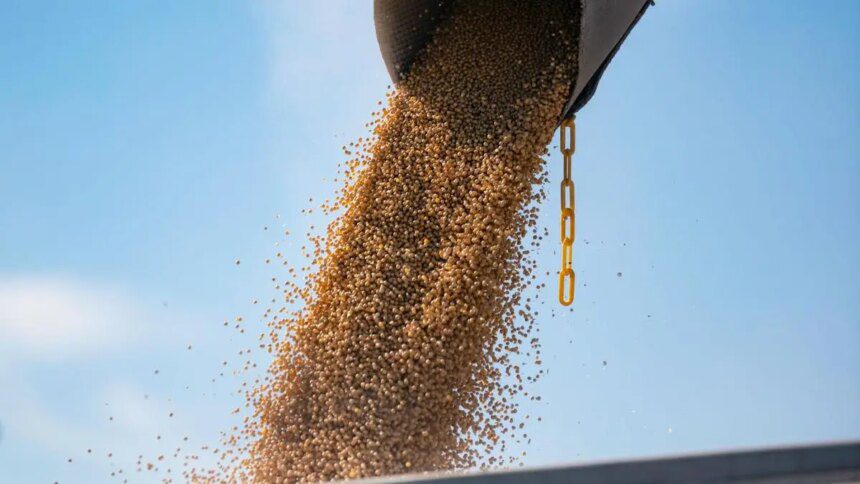U.S. President Donald Trump’s announcement on Tuesday regarding the cessation of soybean oil imports from China is not anticipated to significantly impact Beijing, analysts and industry experts indicate.
This declaration arises against a backdrop where China has yet to purchase any U.S. soybeans for the current season (September 2025-August 2026), leading to downward pressure on soybean prices, which are currently being traded at $10 a bushel ($371 or ₹32,600 a tonne). Kirk Leeds, CEO of the Iowa Soybeans Association, noted, “They (Chinese buyers) have purchased zero U.S. soybeans for delivery. We continue to hope and anticipate that leaders of China and the U.S. will reach a trade agreement.”
This is a notable occurrence as it marks the first time in over 20 years that China has entirely halted soybean purchases from the U.S. during the peak harvest season. Grant Kimberly, Executive Director of the Iowa Soybeans Association, stated, “The trade war and retaliatory tariffs — currently totalling a net difference of 20 percent on U.S. soybeans — have impacted whole soybean exports. However, U.S. soybeans remain cheaper than their South American counterparts.”
Paying Premium to Brazil
Amid its avoidance of U.S. soybeans, China has shifted its focus to acquiring oilseeds from Brazil, albeit at a premium. Industry analysts have observed that China began to distance itself from U.S. soybeans in 2018, following the onset of the trade dispute with Washington. An export inspection executive remarked, “China has assiduously prepared to snub U.S. soybeans in favour of Brazil. Trump’s second term has provided a perfect opportunity.”
Brazil’s soybean production, which totaled 95.7 million tonnes in the 2015-16 season and 114 million tonnes in 2016-17, is projected to reach a record high of 175 million tonnes in the 2025-26 season. Conversely, U.S. production has stagnated at around 116-117 million tonnes during the same period.
Improving Infrastructure
Simultaneously, U.S. soybean exports surged to a record high of 61.66 million tonnes in the 2020-21 season but are expected to decline to a six-year low of 45.86 million tonnes in the 2025-26 season. Brazil’s exports are projected to increase from 108 million tonnes last year to 112 million tonnes in 2025-26, compared to 86.11 million tonnes in 2020-21.
Industry sources highlighted China’s investments aimed at bolstering Brazil’s soybean exports, noting, “China began to improve Brazil’s infrastructure, especially its ports.” This includes a $285 million investment from Kofco to develop a new agricultural export terminal at the Port of Santos, alongside improvements at the Port of São Luís. These efforts have reduced loading times for soybeans from 120 days to 60 days.
Frustrated U.S. Growers
While Brazilian farmers benefit from a guaranteed market and premium prices, U.S. growers continue to face challenges. Leeds noted, “U.S. growers are nervous and frustrated as they continue to harvest another large crop of soybeans.” Kimberly added that China’s refusal to purchase U.S. soybeans appears to be a “political choice” as a negotiation tactic.
American farmers have options to store their crops, with prices for May and June 2026 remaining stable compared to the previous year. However, Kimberly reported a sense of concern and frustration among farmers, characterizing the situation as “dire” for the industry. Farmers face increased input costs, decreasing prices, and restricted market access, with some considering storage strategies while others fear they may not survive another season without substantial support.
Mitigation Bridge
The Iowa Soybean and American Soybean Associations have conveyed their concerns to Congressional leaders, seeking immediate trade negotiations to restore access to the Chinese market. Discussions are centered around potential trade mitigation payments to assist farmers during these challenging times. Meanwhile, Tom Adam, a Board member of the Iowa Soybeans Association, indicated that efforts are ongoing to identify new markets for displaced soybeans resulting from Brazil’s commitments to China.
However, Ameer Mehdi Buhari, Agcore Trading’s President and CEO, expressed skepticism regarding the timing of any potential trade breakthroughs, suggesting that if a resolution were reached now, it might be too late for U.S. exporters. “I don’t think the Chinese volume can be covered by other markets,” he commented, noting that China’s absence from the U.S. market has driven prices to historical lows on the Chicago Board of Trade and CME futures.
Largest Soy Oil Producer
Conversely, China may find it challenging to export its soybean oil, having discovered new buyers. In July, it sold over 120,000 tonnes of oil to India, attracting buyers with discounted prices. According to the USDA, China remains the largest producer of soybean oil, with production estimates of 19.57 million tonnes for the 2024-25 season and projected increases to 20.52 million tonnes in 2025-26.
The U.S. previously accounted for 43 percent of China’s used cooking oil exports; however, the ban on imports could lead to alternative markets emerging for biofuel consumption. Analysts also point out that U.S. soybean crushing has been rising to meet biofuel demands, suggesting China might have anticipated these changes.
The article is published on October 16, 2025.










